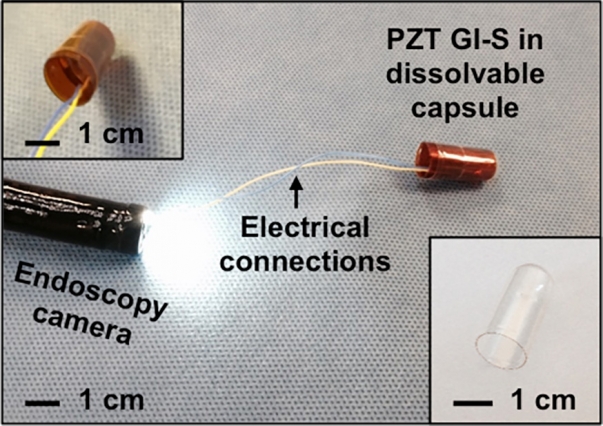Diagnosing stomach and intestinal problems can be hard to do without seeing exactly what’s going on inside. That’s why scientists have for some time been researching the potential behind ingestible sensors. Now one team of researchers from MIT and Brigham and Women’s Hospital are working on one edible device designed with flexible materials and a lack of an installed battery – both of which make the sensor safer for patients to ingest.
The 2 by 2.5 centimeter sensor would come rolled up inside a capsule you swallow.The capsule shell would dissolve in your stomach and let the sensor unfurl and adhere to the inner lining of your stomach or gastrointestinal tract. It has polymers with elasticity similar to that of human skin, allowing it to stretch and contract with the natural rhythmic contractions of the organ. This bending process allows the piezoelectric materials of the sensor to generate an electrical current to power the device. The team reported their research in the latest issue of the journal Nature Biomedical Engineering.
“Having flexibility has the potential to impart significantly improved safety, simply because it makes it easier to transit through the GI tract,” senior authors of the paper Giovanni Traverso said in a statement.

Researchers have so far tested the sensor on pigs by delivering them endoscopically and transmitted information through external cables. To be fair, the pigs didn’t get the luxury of unobtrusively swallowing a pill for this research. But the experiment did provide important information nonetheless. It looks like the soft materials of the sensors can survive the severe environment of the tract for up to two days before mechanical parts start to break down.
In the future, this kind of sensor could help doctors diagnose gastrointestinal disorders by monitoring potential food slowdown. Or it could be used to measure food intake by patients being treated for obesity. “Having a window into what an individual is actually ingesting at home is helpful, because sometimes it’s difficult for patients to really benchmark themselves and know how much is being consumed,” Traverso said.
Of course, there’s still a long way to go before the pill is ready for mainstream consumption. The researchers said one of the things they want to do next is to use some of the energy generated by the piezoelectric material to tack on new features. High on that list is wireless capability so the sensor can get information it retrieves about the gut back out of the body.











